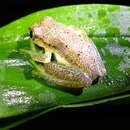Description
provided by AmphibiaWeb articles
A small Heterixalus (SVL of males 22-23 mm); back is whitish with small black spots. Other characters see next section.Holotype: Adult male, ZFMK 57413, from a small artificial lake near the bifurcation of the road to Andasibe from the RN2, central eastern Madagascar. SVL 23 mm, head width 8 mm; eye diameter 3.1 mm, tympanum indistinct; distance eye-nostril 1.9 mm, distance nostril-tip of snout 1.7; hand length 6.5 mm, length of foot and tarsus 15 mm. Tibiotarsal articulation reaches between eye and nostril. Tibia is longer than foot. Tips of fingers and toes circularly enlarged. A nuptial pad is present on the inner side of the first finger. Vomerine teeth are absent. A gular gland is present, and posteriorly slightly notched, thus slightly of kidney shape. Webbing of the hand 1(-), 2i(-), 2e(1), 3i(2), 3e(1.5), 4(1); webbing of the foot 1(0), 2i(1), 2e(0), 3i(1), 3e(0), 4i/e(1.5), 5(0.5). Skin on the back smooth. In life dorsally silvery white with many (ca. 28) small black spots. Flanks and venter yellowish. These two colours border dorsilaterally, and are separated by a dorsilateral line of black spots. A black streak runs from nostril to eye. Paratypes: Two adult males (ZFMK 57414, SVL 23 mm, and ZFMK 57415, SVL 22 mm) from the same locality as holotype. Morphological features and colouration very similar to the holotype. The number of black spots on the back is ca. 22 and 23, respectively. Colour at night yellowish-brown, during the day bright white. The population at the type locality Andasibe, and specimens from Nosy Boraha, have small black spots on dorsum. However, specimens from Sambava are devoid of spots, while the syntopic H. madagascariensis at this locality often does have spots. In all specimens, the white dorsal colour does not extend onto the sides of the head which is yellowish. The feet are yellow and not orange as in H. madagascariensis. Similar species: H. madagascariensis is larger, has no dark spots on the back (as far as known) and differs by call. From H. rutenbergi, H. alboguttatus, H. betsileo, H. luteostriatus, H. andrakata, H. "variabilis" and H. boettgeri it can be easily distinguished by colouration. H. tricolor differs by call and its back is not distinctly spotted.Taken with permission from Glaw and Vences (2007).
Glaw, F. and Vences, M. (2008). Heterixalus punctatus. In: IUCN 2008. 2008 IUCN Red List of Threatened Species. www.iucnredlist.org. Downloaded on 21 April 2009.
- author
- Miguel Vences
- author
- Frank Glaw
Distribution and Habitat
provided by AmphibiaWeb articles
Ambanizana, Andapa, Andasibe (TL), Anjanaharibe, Antalaha, Nosy Boraha, Sambava.It occurs from sea level to 900m asl in open areas of rainforest belt and agricultural land, especially in rice fields (Glaw and Vences 2008).
- author
- Miguel Vences
- author
- Frank Glaw
Life History, Abundance, Activity, and Special Behaviors
provided by AmphibiaWeb articles
Habits: Calling males were found in sun-exposed swamps from December to March. At Andasibe they occured in syntopy with H. betsileo, at Sambava in syntopy with H. andrakata and H. cf. madagascariensis. Call (from the terra typica, ca. 20�C): The call consists of several (2-7) unharmonious notes. Although some notes are more accentuated than others, two distinct note types arranged in regular combinations were not heard. Note duration is 47-68 ms, duration of intervals between notes is 210-375 ms, giving a total call duration of 350-1700 ms and a note repetition rate of 4.1/s. Frequency is between 3 and 4.3 kHz. Similar calls were heard at Nosy Boraha, and recorded at Sambava (ca. 24�C). Note repetition rate at Sambava is 6.1/s. Breeding occurs in temporary and permanent still water (Glaw and Vences 2008).
- author
- Miguel Vences
- author
- Frank Glaw
Life History, Abundance, Activity, and Special Behaviors
provided by AmphibiaWeb articles
It occurs in Parc National de Masoala and in the Analamazoatra Special Reserve (Glaw and Vences 2008).
- author
- Miguel Vences
- author
- Frank Glaw
Heterixalus punctatus: Brief Summary
provided by wikipedia EN
Heterixalus punctatus is a species of frogs in the family Hyperoliidae endemic to Madagascar. Its natural habitats are subtropical or tropical moist lowland forests, swamps, freshwater marshes, intermittent freshwater marshes, arable land, rural gardens, heavily degraded former forests, ponds, irrigated land, and seasonally flooded agricultural land.
- license
- cc-by-sa-3.0
- copyright
- Wikipedia authors and editors

